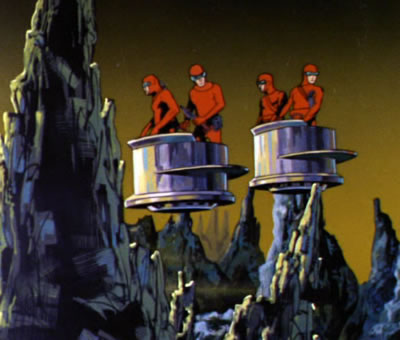
Conceptual illustration of a nano-patterned object reorienting itself to remain in a beam of light
(Credit: Courtesy of the Atwater laboratory)

Though still theoretical, the work is a step toward developing a spacecraft that could reach the nearest planet outside of our solar system in 20 years, powered and accelerated only by light.
A paper describing the research appears online in the March 18 issue of the journal Nature Photonics. The research was done in the laboratory of Harry Atwater, Howard Hughes Professor of Applied Physics and Materials Science in Caltech's Division of Engineering and Applied Science.
Decades ago, the development of so-called optical tweezers enabled scientists to move and manipulate tiny objects, like nanoparticles, using the radiative pressure from a sharply focused beam of laser light. This work formed the basis for the 2018 Nobel Prize in Physics. However, optical tweezers are only able to manipulate very small objects and only at very short distances.
Ognjen Ilic, postdoctoral scholar and the study's first author, gives an analogy: "One can levitate a ping pong ball using a steady stream of air from a hair dryer. But it wouldn't work if the ping pong ball were too big, or if it were too far away from the hair dryer, and so on."
With this new research, objects of many different shapes and sizes—from micrometers to meters—could be manipulated with a light beam. The key is to create specific nanoscale patterns on an object's surface. This patterning interacts with light in such a way that the object can right itself when perturbed, creating a restoring torque to keep it in the light beam. Thus, rather than requiring highly focused laser beams, the objects' patterning is designed to "encode" their own stability. The light source can also be millions of miles away.
"We have come up with a method that could levitate macroscopic objects," says Atwater, who is also the director of the Joint Center for Artificial Photosynthesis. "There is an audaciously interesting application to use this technique as a means for propulsion of a new generation of spacecraft. We're a long way from actually doing that, but we are in the process of testing out the principles."
In theory, this spacecraft could be patterned with nanoscale structures and accelerated by an Earth-based laser light. Without needing to carry fuel, the spacecraft could reach very high, even relativistic speeds and possibly travel to other stars.
Atwater also envisions that the technology could be used here on Earth to enable rapid manufacturing of ever-smaller objects, like circuit boards.
The paper is titled "Self-stabilizing photonic levitation and propulsion of nanostructured macroscopic objects." Funding was provided by the Air Force Office of Scientific Research.
Explore further: Research paves the way for next generation of optical tweezers
More information: Self-stabilizing photonic levitation and propulsion of nanostructured macroscopic objects. Nature Photonics doi.org/10.1038/s41566-019-0373-y
In before the gif of Homer Simpson being lifted into the UFO by the tractor beams.
Contents
1 Discovery
2 Theory
2.1 Radiation pressure from momentum of an electromagnetic wave
2.2 Radiation pressure from reflection
2.3 Radiation pressure by emission
2.4 Radiation pressure in terms of photons
2.5 Compression in a uniform radiation field
3 Solar radiation pressure
3.1 Pressures of absorption and reflection
3.2 Radiation pressure perturbations
3.3 Solar sails
4 Cosmic effects of radiation pressure
4.1 The early universe
4.2 Galaxy formation and evolution
4.3 Clouds of dust and gases
4.4 Clusters of stars
4.5 Star formation
4.6 Stellar planetary systems
4.7 Stellar interiors
4.8 Comets
5 Laser applications of radiation pressure
5.1 Optical tweezers
5.2 Other examples
6 See also
7 References
8 Further reading
Radiation pressure is the pressure exerted upon any surface due to the exchange of momentum between the object and the electromagnetic field. This includes the momentum of light or electromagnetic radiation of any wavelength which is absorbed, reflected, or otherwise emitted (e.g. black-body radiation) by matter on any scale (from macroscopic objects to dust particles to gas molecules).[1][2][3]
The forces generated by radiation pressure are generally too small to be noticed under everyday circumstances; however, they are important in some physical processes. This particularly includes objects in outer space where it is usually the main force acting on objects besides gravity, and where the net effect of a tiny force may have a large cumulative effect over long periods of time.
For example, had the effects of the sun’s radiation pressure on the spacecraft of the Viking program been ignored, the spacecraft would have missed Mars orbit by about 15,000 km (9,300 mi).[4] Radiation pressure from starlight is crucial in a number of astrophysical processes as well.
The significance of radiation pressure increases rapidly at extremely high temperatures, and can sometimes dwarf the usual gas pressure, for instance in stellar interiors and thermonuclear weapons.
Radiation pressure can equally well be accounted for by considering the momentum of a classical electromagnetic field or in terms of the momenta of photons, particles of light.
The interaction of electromagnetic waves or photons with matter may involve an exchange of momentum.
Due to the law of conservation of momentum, any change in the total momentum of the waves or photons must involve an equal and opposite change in the momentum of the matter it interacted with (Newton’s third law of motion), as is illustrated in the accompanying figure for the case of light being perfectly reflected by a surface.
This transfer of momentum is the general explanation for what we term radiation pressure. ...”

Well, if light can be bent by gravity, why not gravity bent by light?
Tractor beam!
Researchers at the California Institute of Technology believe that by covering the surfaces of objects with microscopic nanoscale patterns specially designed to interact with beams of light, they could be propelled without fuel.....
---------------------------------------------------------
So they haven't actually done it?
Fascinating, but scientists have already found a way to levitate objects with TNT.
Paging Art Bell...
No matter where you are in the universe, the time is always now.
Light sails were discussed in SciFi way back in the 50’s and 60’s, as were laser propelled space craft in the 70’s.
May be exciting, but it is not new.
That’s easy. Turn the light on at 2 am on someone who’s sleeping and watch them levitate.
This is why I do an eye-roll when the argument "There can't be aliens visiting us because . . ." arises.
We don't know what is around the next scientific corner and just because humans haven't invented something, doesn't mean someone/something else hasn't either.
I remember reading that scientists in the 1890s said people couldn't travel faster than 60 mph as they would suffocate. In Gen. Grant's biography, he said, as a young man taking his first trip on a train going 35 mph, "We have annihilated space!".